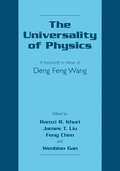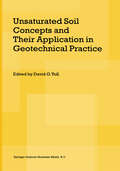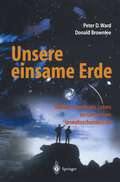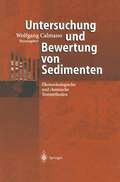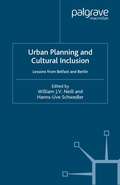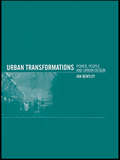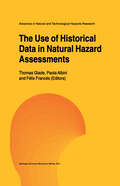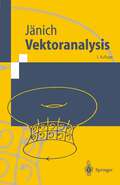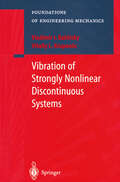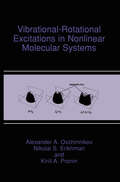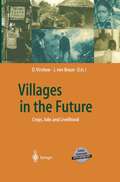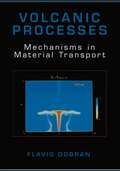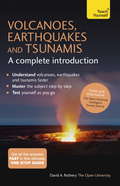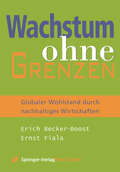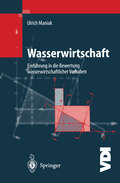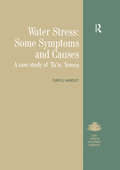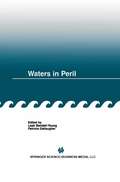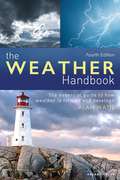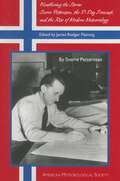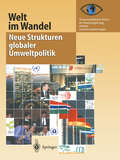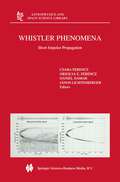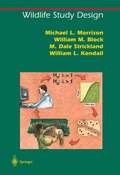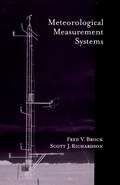- Table View
- List View
The Universality of Physics: A Festschrift in Honor of Deng Feng Wang
by Ramzi R. Khuri James T. Liu Feng Feng Chen Wenbiao Wenbiao GanDeng Feng Wang was born February 8, 1965 in Chongqing City, China and died August 15, 1999 while swimming with friends in the Atlantic Ocean off Island Beach State Park, New Jersey. In his brief life, he was to have an influence far beyond his years. On August 12th 2000, The Deng Feng Wang Memorial Conference was held at his alma mater, Princeton University, during which Deng Feng's mentors, collaborators and friends presented scientific talks in a testimonial to his tremendous influence on their work and careers. The first part of this volume contains proceedings contributions from the conference, with plenary talks by Nobel Laureate Professor Phil Anderson of Princeton University and leading Condensed Matter Theorists Professor Piers Coleman of Rutgers University and Professor Christian Gruber of the University of Lausanne. Other talks, given by collaborators, friends and classmates testify to the great breadth of Deng Feng Wang's influence, with remarkable connections shown between seemingly unrelated areas in physics such as Condensed Matter Physics, Superconductivity, One-Dimensional Models, Statistical Physics, Mathematical Physics, Quantum Field Theory, High Energy Theory, Nuclear Magnetic Resonance, Supersymmetry, M-Theory and String Theory, in addition to such varied fields outside of physics such as Oil Drilling, Mixed Signal Circuits and Neurology. The second part of the volume consists of reprints of some of Deng Feng Wang's most important papers in the areas of Condensed Matter Physics, Statistical Physics, Magnetism, Mathematical Physics and Mathematical Finance. This volume represents a fascinating synthesis of a wide variety of topics, and ultimately points to the universality of physics and of science as a whole. As such, it represents a fitting tribute to a remarkable individual, whose tragic death will never erase his enduring influence.
Unsaturated Soil Concepts and Their Application in Geotechnical Practice
by D. G. Tollmodel. They conclude that the models using three fitting parameters provide the best fit over a wide range of suctions. Models for soil-water characteristic curves are only useful if we have experimental data on which to base them. Agus, Leong and Rahardjo (Singapore) present a large number of experimental soil-water characteristic curves determined for two types of residual soil from Sigapore. They present data for eight different sites. This data set allows them to relate the parameters of the soil-water characteristic curves to index properties. They conclude that the relationships derived are suitable to pro vide a quick preliminary estimate of a soil-water characteristic curve. The importance of soil-water characteristic curves is emphasized by another con tribution dealing with this topic. Aung, Rahardjo, Leong and Toll (Singapore) inves tigate the relationship between mercury intrusion porosimetry measurements and soil-water characteristic curves. The porosimetry measurements are presented as soil-air characteristic curves. The slopes of the soil-air characteristic curves are found to be similar to the slopes of the soil-water characteristic curves. The equiv alent pore diameters calculated from the mercury entry value and the air entry value appear to be related. Therefore, it is suggested that porosimetry data can be used to construct an estimate of the soil-water characteristic curve.
Unsere einsame Erde
by Peter D. Ward Donald BrownleeSind wir vielleicht allein im Universum? Die Antworten überraschen und führen den Leser auf eine faszinierende Reise von den vulkanischen Quellen des Ozeanbodens bis zum Jupiter-Mond."...ein stellares Beispiel präziser Ausdruckskraft." (American Scientist)
Untersuchung und Bewertung von Sedimenten: Ökotoxikologische und chemische Testmethoden
by Wolfgang CalmanoUrban Planning and Cultural Inclusion: Lessons from Belfast and Berlin (Anglo-German Foundation)
by W. Neill H. SchwedlerCities divided by ethnic and cultural conflict need to identify, create and maintain some kind of shared identity amongst their inhabitants, if they wish to survive in competition with one another and not be submerged in tensions. Urban planning and city management can take these identities on board constructively and can assist them without allowing the city to deteriorate into a disconnected and hostile conglomeration. Belfast and Berlin are currently in the process of responding to this challenge: What will the implications be for town planners and how do they approach their task?
Urban Transformations: Power, People and Urban Design
by Ian BentleyCities affect every person's life, yet across the traditional divides of class, age, gender and political affiliation, armies of people are united in their dislike of the transformations that cities have undergone in recent times. The physical form of the urban environment is not a designer add-on to 'real' social issues; it is a central aspect of the social world. Yet in many people's experience, the cumulative impacts of recent urban development have created widely un-loved urban places. To work towards better-loved urban environments, we need to understand how current problems have arisen and identify practical action to address them.Urban Transformations examines the crucial issues relating to how cities are formed, how people use these urban environments and how cities can be transformed into better places. Exploring the links between the concrete physicality of the built environment and the complex social, economic, political and cultural processes through which the physical urban form is produced and consumed, Ian Bentley proposes a framework of ideas to provoke and develop current debate and new forms of practice.
Urban Transformations: Power, People and Urban Design
by Ian BentleyCities affect every person's life, yet across the traditional divides of class, age, gender and political affiliation, armies of people are united in their dislike of the transformations that cities have undergone in recent times. The physical form of the urban environment is not a designer add-on to 'real' social issues; it is a central aspect of the social world. Yet in many people's experience, the cumulative impacts of recent urban development have created widely un-loved urban places. To work towards better-loved urban environments, we need to understand how current problems have arisen and identify practical action to address them.Urban Transformations examines the crucial issues relating to how cities are formed, how people use these urban environments and how cities can be transformed into better places. Exploring the links between the concrete physicality of the built environment and the complex social, economic, political and cultural processes through which the physical urban form is produced and consumed, Ian Bentley proposes a framework of ideas to provoke and develop current debate and new forms of practice.
The Use of Historical Data in Natural Hazard Assessments (Advances in Natural and Technological Hazards Research #17)
by FélixFrancés PaolaAlbini ThomasGladeNatural hazards such as earthquakes, landslides, floods, volcanic eruptions, tsunamis, and hurricanes cause environmental, economic as well as sociological problems worldwide. In recent years, greater availability of information and sensational media reports of natural hazard occurrence -and in particular in terms of property damage or loss oflife caused by these hazards -resulted in an increase of hazard awareness at a societal level. This increase in public awareness has often been misconstrued as an indication that natural hazards have been occurring more frequently with higher magnitudes in recent years/decades, thus causing more damage than in the past. It is still under debate, however, to which extent recent increases in damage can be related to changing frequencies of natural processes, or whether catastrophic events occur at similar rates as they always had. If the latter is the case, the reason for a greater damage can be related to dramatic population growth over the last century, with a substantial augmentation of population density in some regions. Indeed, the implications are more server in underdeveloped and developing countries, where urbanisation has increasingly occurred in hazard prone areas such as coastal zones, alluvial river plains and steep slopes, thus causing an increase in the exposure to natural hazards. Some groups of society in wealthy countries accept higher risks in order to live directly on top of a cliff or on a steep slope to enjoy panoramic views of the landscape.
Vektoranalysis (Springer-Lehrbuch)
by Klaus JänichDie Vektoranalysis handelt, in klassischer Darstellung, von Vektorfeldern, den Operatoren Gradient, Divergenz und Rotation, von Linien-, Flächen- und Volumenintegralen und von den Integralsätzen von Gauß, Stokes und Green. In moderner Fassung ist es der Cartansche Kalkül mit dem Satz von Stokes. Das vorliegende Buch vertritt grundsätzlich die moderne Herangehensweise, geht aber auch sorgfältig auf die klassische Notation und Auffassung ein. Das Buch richtet sich an Mathematik- und Physikstudenten ab dem zweiten Studienjahr, die mit den Grundbegriffen der Differential- und Integralrechnung in einer und mehreren Variablen sowie der Topologie vertraut sind. Der sehr persönliche Stil des Autors und die aus anderen Büchern bereits bekannten Lernhilfen, wie: viele Figuren, mehr als 50 kommentierte Übungsaufgaben, über 100 Tests mit Antworten, machen auch diesen Text zum Selbststudium hervorragend geeignet.
Vibration of Strongly Nonlinear Discontinuous Systems (Foundations of Engineering Mechanics)
by V.I. Babitsky V.L. KrupeninThis monograph addresses the systematic representation of the methods of analysis developed by the authors as applied to such systems. Particular features of dynamic processes in such systems are studied. Special attention is given to an analysis of different resonant phenomena taking unusual and diverse forms.
Vibrational-Rotational Excitations in Nonlinear Molecular Systems
by Alexander A. Ovchinnikov Nikolai S. Erikhman Kirill A. Pronin"If there would be no God ~ then what a staff-captain am I?" ~ said one of the characters in a novel by Dostoevskii. In a similar way we can exclaim: "If there would be no nonlinearity ~ than what physics would that be'?". Really, the most interesting and exciting effects are described by non linear equations, and vanish in the linear approximation. For example, the general theory of relativity by A.Einstein comes to mind first - one of the most beautiful physical theories, which is in fact essentially nonlinear. Next, the phase transitions crystal ~ liquid and liquid ~ gas are due to the anhar monicity of inter-particle interactions, to dissociation and infinite motion. Similarly, transitions into the superconducting state or the superftuid would be impossible with purely harmonic interaction potentials. Another bril liant achievement in nonlinear physics was the construction of a laser and the subsequent development of nonlinear optics. The latter describes the in teraction of the matter with light of super-high intensity, when multi-quanta intra-molecular transitions become essential. Last, we should note here the very beautiful mathematical theory ~ the theory of catastrophes. Its subject is the study of invariant general properties of multi-dimensional surfaces in the vicinity of bifurcation points with respect to continuous transformations.
Villages in the Future: Crops, Jobs and Livelihood (Global Dialogue EXPO 2000)
by Detlef Virchow Joachim Von BraunLife in rural communities is bound to change with historically unprecedented speed in the coming decades. How will this change be guided by local, national and global policies in order to enhance the livelihoods of rural inhabitants and to overcome the growing division of rural and urban areas? The contributions in this publication, ranging from scientific papers to short reports from practitioners, are grouped around 4 major themes: political and institutional frameworks to foster rural development; natural resources management; broadening the technological base of rural economies; and improved linkages between urban and rural areas. The overall message is unanimous: there is a promising future for the rural areas worldwide if adequate policies can be enforced and more efficient and fair institutions can be created.
Volcanic Processes: Mechanisms in Material Transport
by Flavio DobranVolcanic eruptions are fascinating manifestations of the Earth's dynamic inte rior which has been cooling for the past several billion years. The planets of the solar system originated some 4.5 billion years ago from the same gas and dust cloud created by the big bang. Some of the gas collapsed by the gravitational force to form the Sun at the center, while the whirling disk of gas and dust around the Sun subsequently cooled and lumped together to form larger and larger lumps of materials or planetesimals. These planetesimals collided fre quently and violently and in the process liberated heat that melted the material in them. With time this material gradually cooled and formed the planets of the solar system. During the second half of the twentieth century the theory of plate tectonics of the Earth became established and demonstrated that our planet is covered with six large and many small plates of the lithosphere. These plates move over a highly viscous lower part of the Earth's upper mantle and contain the continental and oceanic crusts. The lower mantle extends below the upper mantle until it meets the core that is more than half the diameter of the entire globe (12,740 km). The inner core consists mostly of iron and its temperature is about 5000 kelvin, whereas the liquid outer core is turbulent, rotates faster than the mantle, consists primarily of iron, and is the source of the Earth's magnetic field.
Volcanoes, Earthquakes and Tsunamis: A Complete Introduction: Teach Yourself
by David RotheryWritten by Dr David Rothery, a volcanologist, geologist, planetary scientist and Professor of Planetary Geosciences at the Open University, Volcanoes, Earthquakes and Tsunamis: A Complete Introduction is designed to give you everything you need to succeed, all in one place. It covers the key areas that students are expected to be confident in, outlining the basics in clear English and providing added-value features like a glossary of essential terms and even examples of questions you might be asked in your seminar or exam.The book uses a structure chosen to cover the essentials of most university courses, with an introduction on how the Earth moves, followed by separate sections on volcanoes (including eruptions, types of volcano, volcanic hazards, volcanoes and climate, monitoring volcanoes, predicting eruptions and living with volcanoes), earthquakes (including faults, measurement, seismic monitoring, prediction, prevention and preparedness) and tsunamis.
Wachstum ohne Grenzen: Globaler Wohlstand durch nachhaltiges Wirtschaften
by Erich Becker-Boost Ernst FialaZwischen der Wirtschaftsleistung pro Kopf und wichtigen gesellschaftlichen Rahmenbedingungen wie z.B. Energiebedarf, Umweltbelastung, Bevölkerungs- und Wirtschaftswachstum, Mobilität, Ausbildung, Lebenserwartung und Gewaltbereitschaft besteht ein enger Zusammenhang. Die Autoren kommen in ihrer Analyse zu überraschenden Ergebnissen: • steigende Wirtschaftsleistung verbessert fast alle Lebensumstände und bringt das Bevölkerungswachstum zum Stillstand • die Wirtschaft kann und wird weiter wachsen: die Ressourcen sind unerschöpflich, wenn Ersatz akzeptiert wird (z.B. Recycling, nachwachsende Rohstoffe, Keramik statt Metall) • der Energiebedarf kann auch ohne fossile Energie vollständig durch die Rückkehr in den natürlichen Energiekreislauf gedeckt werden • eine geschlossene Kreislaufwirtschaft wird neue Arbeitsplätze entstehen lassen • die Belastung der Umwelt kann in Grenzen gehalten werden, vorausgesetzt, dass die wirtschaftliche Leistungsfähigkeit dazu ausreicht • die ethischen Voraussetzungen für das Zusammenleben verbessern sich mit der nachhaltigen Wirtschaftsentwicklung Der pessimistischen Erwartung der letzten Jahrzehnte bezüglich unserer Zukunft wird hier eine realistische Alternative gegenübergestellt. Zukünftigen Generationen hinterlassen wir nicht eine geplünderte Erde, sondern das Know-how für nachhaltiges Wirtschaften!
Wasserwirtschaft: Einführung in die Bewertung wasserwirtschaftlicher Vorhaben (VDI-Buch)
by Ulrich ManiakWater Stress: A Case Study of Ta'iz, Yemen (King's SOAS Studies in Development Geography)
by Chris D. HandleyWhy is the bread basket of Arabia importing more water via grain than is pumped locally by all sectors and why does nobody notice? How can the same water be sold to different users at prices varying by five orders of magnitude? How can the biggest names in development throw millions of dollars at supplying water to a city and not an extra drop has emerged? Why do some of the wealthiest companies in the Middle East and their multinational associates get away with polluting water resources? This book presents the complex and fascinating account of Ta'iz, Yemen, a city embroiled in severe water stress as a consequence of environmental degradation, political facades, conflicting legal systems, military intervention and institutional incompetence. The result is a remarkable, compelling and controversial book which will be essential reading for academics, development agencies and NGOs around the world.
Water Stress: A Case Study of Ta'iz, Yemen (King's SOAS Studies in Development Geography)
by Chris D. HandleyWhy is the bread basket of Arabia importing more water via grain than is pumped locally by all sectors and why does nobody notice? How can the same water be sold to different users at prices varying by five orders of magnitude? How can the biggest names in development throw millions of dollars at supplying water to a city and not an extra drop has emerged? Why do some of the wealthiest companies in the Middle East and their multinational associates get away with polluting water resources? This book presents the complex and fascinating account of Ta'iz, Yemen, a city embroiled in severe water stress as a consequence of environmental degradation, political facades, conflicting legal systems, military intervention and institutional incompetence. The result is a remarkable, compelling and controversial book which will be essential reading for academics, development agencies and NGOs around the world.
Waters in Peril
by PatriciaGallaugher LeahBendell-YoungWho Speaks for the Oceans? The question has been asked a lot in recent years - just who is looking out for our oceans? Covering over seventy percent of the earth's surface it is the world's largest common property resource,jojntly owned by over six billion humans. It is the foundation for life on earth as we know it. Over the years, many people have spoken about various aspects of our ocean environments and they have spoken to different audiences in many different ways. For many in the public realm, Jacques Cousteau spoke for the ocean. Since his passing, no single voice with the sallle public identity or recognition has emerged. Certainly the many governments bordering our oceans cannot agree on common principles or issues of ocean use and management. We might be tempted think that we do not have an ocean spokesperson or champion, but we would be wrong. Today, the rapidly growing number of scientists working hard to expand our under standing of our ocean realm are the ocean voices we should listen to. At the same time as our scientists advance their understanding of the oceans, we all need to advance our abilities and commitment to communicate on behalf of the oceans with broader and broader audiences who need to be aware of where things stand. Often called "the last great frontier", earth's oceans are vast, widely varied, and are hard to get to, arid into, to do the research we need done.
The Weather Handbook: The Essential Guide to How Weather is Formed and Develops
by Alan WattsThe Weather Handbook is the essential guide to how the weather is formed, providing readers with the ability to look at the sky and interpret its signs, and combine this knowledge with information provided by professional forecasts to assess for themselves what the coming weather is likely to be.This handbook has been the standard reference for over 20 years for students on Day Skipper and Yachtmaster courses, and the handbook of choice for skippers and crew of cruising and racing yachts. The fourth edition has been updated and expanded with new photos and explanatory text, addressing new sources of weather information. There are countless websites and apps providing forecast data, and The Weather Handbook guides users in how to use and interpret this information for themselves, taking a general forecast for a wide area to provide a local forecast for a specific location.'The perfect introduction to understanding weather' Practical Boat Owner
Weathering the Storm: Sverre Petterssen, the D-Day Forecast, and the Rise of Modern Meteorology
by James FlemingThis book presents the memoirs of Sverre Pettersen, prominent leader in the field of meteorology. Delving through his recollections of his childhood in Norway, education and work at the famous Bergen school of Meteorology to the World War II crisis and D-Day, Petterssen uncovers the history of meteorology, documenting it from his perspective. Meteorology today is the beneficiary of his work.
Welt im Wandel: Neue Strukturen globaler Umweltpolitik (Welt im Wandel)
by Wissenschaftlicher Beirat der Bundesregierung GlobTrotz 900 bi- oder multilateraler Umweltverträge bleiben die drängendsten Probleme des globalen Wandels ungelöst. Das internationale Organisationengefüge konnnte diesen Herausforderungen nicht effektiv und effizient begegnen. Daher entwickelt der Wissenschaftliche Beirat der Bundesregierung Globale Umweltveränderungen (WBGU) eine Vision für eine Reform der Vereinten Nationen im Umweltbereich ("Earth Alliance"). Die Earth Alliance umfaßt drei miteinander vernetzte Bereiche. Es wird erstens die Einrichtung einer unabhängigen Instanz vorgeschlagen, die auf besonders risikoreiche Entwicklungen des globalen Wandels (früh-)warnend hinweisen soll (Earth Assessment). Zweitens werden Änderungen des organisatorischen Kerns der internationalen Umweltpolitik empfohlen (Earth Organization). Drittens werden neue Wege zur Finanzierung globaler Umweltpolitik aufgezeigt (Earth Funding). Die Vorschläge des Beirats verstehen sich auch als Beitrag zur Rio+10-Konferenz.
Whistler Phenomena: Short Impulse Propagation (Astrophysics and Space Science Library #262)
by C. Ferencz O. Ferencz D. Hamar J. LichtenbergerIn this volume, the authors present theoretical explanations for a few basic problems connected with the propagation of extra wide band, short impulses in linear media, and with the propagation of whistlers and megawhistlers in plasmas. In addition, the book provides an overview of ground and space based measurements, digital processing and signal analysis. The theoretical treatment in this volume is original in the sense that, unlike former solutions, the authors present a fundamentally non-monochromatic approach. A key feature of this approach is the application of the `Laplace Transformation' and the `Method of Inhomogeneous Basic Modes' to solve Maxwell's equations. It is shown that when the obtained theoretical results are applied to digital recordings, the wave analysis process becomes so flexible that it can also be used to investigate other wave propagation problems. These are both terrestrial phenomena (like atmospheric and seismic activity, buried target detection, etc.) and phenomena in space (planetary, interplanetary, plasmaspheric, whistler and megawhistler propagation). The book is aimed at a technical and professional audience working on whistler science and/or wave propagation problems.
Wildlife Study Design (Springer Series on Environmental Management)
by Michael L. Morrison W.L. Kendall William M. Block M. Dale StricklandWildlife Study Design is a comprehensive guide to all aspects of study design. It including a survey of major types of studies and variables, impact assessment, sampling techniques, inventorying and monitoring, and analysis of data. The book includes a practical, step-by-step guide to setting up a new study. Minimal mathematical notation and examples drawn from field research make applied animal ecology both accessible and relevant. Resource managers, researchers, and students of wildlife and conservation biology will find this book a fundamental resource for implementing and evaluating appropriate studies.
Meteorological Measurement Systems
by Fred V. Brock Scott J. RichardsonThis book treats instrumentation used in meteorological surface systems, both on the synoptic scale and the mesoscale, and the instrumentation used in upper air soundings. The text includes material on first- and second-order differential equations as applied to instrument dynamic performance, and required solutions are developed. Sensor physics are emphasized in order to explain how sensors work and to explore the strengths and weaknesses of each design type. The book is organized according to sensor type and function (temperature, humidity, and wind sensors, for example), though several unifying themes are developed for each sensor. Functional diagrams are used to portray sensors as a set of logical functions, and static sensitivity is derived from a sensor's transfer equation, focusing attention on sensor physics and on ways in which particular designs might be improved. Sensor performance specifications are explored, helping to compare various instruments and to tell users what to expect as a reasonable level of performance. Finally, the text examines the critical area of environmental exposure of instruments. In a well-designed, properly installed, and well-maintained meteorological measurement system, exposure problems are usually the largest source of error, making this chapter one of the most useful sections of the book.
